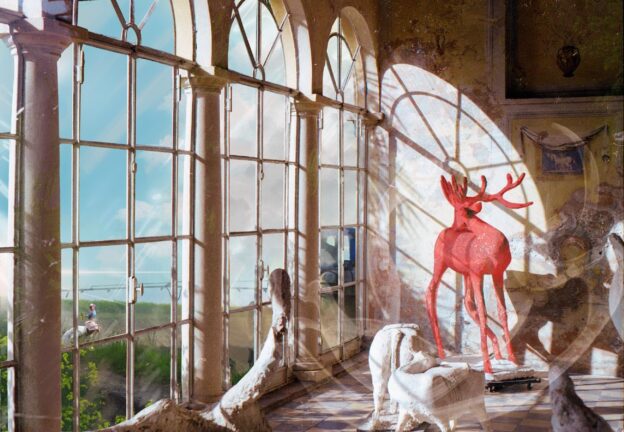By Friederike Uebel
As the creator of this artwork, I aimed to juxtapose the harsh reality of industrial agriculture with the gentler, sustainable practices of traditional farming. This piece serves as a stark reminder of the impact our choices have on biodiversity and the environment.
The centrepiece of the image is a museum exhibit, displaying various animals we still have today, but eerily labelled as extinct a century from now. The red deer, a species not currently critically endangered, is prominently featured. Its presence highlights the looming threat that industrial agriculture poses to flora and fauna. The exhibit is a forewarning, a projection of what might come if we continue on our current path.
Through the museum windows, the scene outside is twofold. On one side, a tractor sprays pesticides over a field under ominous grey clouds, symbolizing the destructive consequences of industrial farming. The pesticides, drifting like a toxic shroud, are a direct contributor to biodiversity loss and environmental degradation.
Contrasting this, the other side of the window shows people working the land with traditional methods. This ‘Window of Opportunity’ represents the potential for positive change. It suggests that by adopting sustainable practices, we can alter the trajectory of our future on Earth.
Through this artwork, I strive to evoke a sense of urgency and contemplation, encouraging viewers to reflect on the paths we tread and the legacy we wish to leave behind. It is both a warning and a beacon of hope, reminding us that the future of our planet rests in our hands.
Friederike is an artist, educator and visual storyteller. Her ‘Window of Opportunity’ artwork was created as part of an OU Open Societal Challenges funded project:
Tree Connections: Decarbonisation and Sustainable Food through the Arts (open.ac.uk)
The project investigated how the arts and artistic activities can help both secular and faith-based organisations communities reflect on issues connected with sustainable food.
Browse more links about Eco Art at The Open University:
Arts & Environment Blog Posts – The Open College of the Arts
Art and attitudes to the climate crisis | The Open University
Student work – Art & Ecology – The Open College of the Arts
Dr Maria Nita, who worked with the artist, adds:
Influential philosophers like Kant, Nietzsche and Wittgenstein talked about the role of art in making us better humans. For Kant, imagination was a bridge between rationality and judgement—a unique mode of aesthetic, reflective and moral cognition. Contemporary voices still debate whether art can improve us. Can art exert some form of moral influence on us? Can art develop our moral imagination so that we can ‘revalue’ the world and our experience? Can we ‘a re-imagine’ our relationships with other species through an artistic engagement with the climate crisis? In a lecture given in 1972 the Norwegian philosopher Arne Naess famously called for such a ‘re-imagining’ as he first distinguished between ‘shallow’ and ‘deep ecology’. Deep Ecology was concerned with fundamental questions about how humans needed to interact with and relate to everything around them. Friederike Uebel’s art is boldly calling us to a deep re-imagining of our ecological future.

